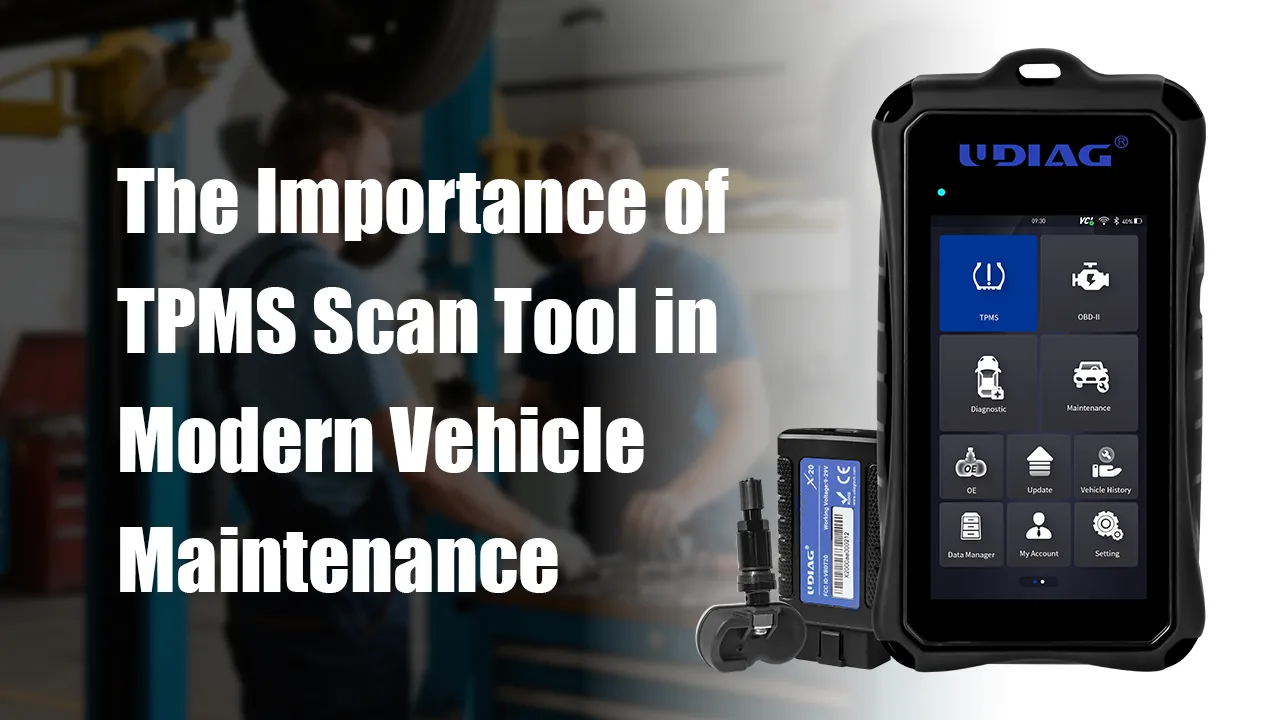The Importance of TPMS Scan Tool in Modern Vehicle Maintenance
2025-11-18 by UDIAG

Introduction:
Tire Pressure Monitoring Systems have become an essential part of today’s automotive service workflow. As vehicle electronics grow more complex, proper tire pressure diagnostics now require more than visual inspection or basic gauges. A professional TPMS scan tool gives technicians the accuracy, efficiency, and reliability needed to service modern vehicles without risking system malfunction or safety issues.
Why Accurate Tire Pressure Diagnostics Matter
Tire pressure affects driving stability, braking distance, fuel economy, and tire lifespan. Even a slight deviation can trigger dashboard alerts or lead to unpredictable tire behavior. Since most vehicles are equipped with direct TPMS sensors, any service involving tire rotation, replacement, or sensor programming demands precise electronic communication. A TPMS scan tool ensures technicians can read sensor data, diagnose faults, and avoid unnecessary part replacements.
How a TPMS Scan Tool Supports Efficient Workshop Operations
A dedicated TPMS scan device can streamline multiple steps during tire service. Technicians can quickly retrieve live sensor information such as pressure, temperature, battery status, and sensor ID. This level of transparency speeds up troubleshooting and eliminates guesswork. Additionally, automatic sensor relearning and programming functions reduce the time normally spent on manual procedures, allowing workshops to improve vehicle throughput and minimize downtime.
Preventing False Alerts and Safety Risks
A faulty TPMS sensor or incorrect sensor configuration can easily trigger warning lights. When drivers continue operating vehicles with active alerts, they may overlook real tire pressure issues, increasing safety risks. A TPMS scanner helps identify defective sensors, mismatched IDs, or communication errors. Correcting these issues maintains compliance with safety standards and prevents potential liability concerns for the workshop.
Ensuring Compatibility with Modern Vehicle Models
Automakers frequently update sensor protocols and communication standards. A professional TPMS scan tool that supports wide vehicle coverage and regular software updates keeps technicians prepared for new models. This compatibility ensures consistent performance for vehicles using different sensor frequencies, OEM protocols, or aftermarket replacement sensors.
Enhancing Customer Trust Through Professional TPMS Service
Customers rely on workshops to ensure vehicle safety and reliability. When technicians use advanced diagnostic tools, they demonstrate professionalism and technical competence. Providing accurate TPMS checks with a scan tool reduces the likelihood of comebacks, builds customer confidence, and strengthens long-term service relationships.
Key Features to Look for in a TPMS Scan Tool
When selecting a diagnostic device, workshops should evaluate several critical capabilities to ensure long-term value.
Comprehensive Sensor Reading Function
A reliable tool must read pressure, temperature, battery life, and sensor ID across various TPMS sensor types. Consistent and accurate readings help technicians quickly identify abnormal values.
Sensor Programming and Relearning
An effective TPMS scan tool should support sensor cloning, programming new sensors, and performing relearn procedures. These functions reduce replacement errors and improve workflow efficiency.
Broad Vehicle Coverage
Coverage across American, European, and Asian vehicle brands ensures the tool is useful for diverse customer groups. Software updates are also essential for staying aligned with new model releases.
User-Friendly Interface for Faster Diagnostics
Clear menu structures, intuitive icons, and step-by-step guidance help technicians perform sensor relearning or programming even in complex situations. A straightforward interface minimizes training time and reduces operational mistakes.
Durable Hardware for Workshop Conditions
Since tire service environments involve dust, vibration, and temperature variations, the tool should feature rugged construction, stable wireless communication, and long-lasting battery performance.
Conclusion
The TPMS system plays a crucial role in vehicle safety, fuel efficiency, and driving comfort. UDIAG X-20 professional TPMS tool enhances diagnostic precision, improves workflow efficiency, and ensures workshop readiness for increasingly advanced vehicles. As sensor technologies continue to evolve, investing in a capable TPMS diagnostic device becomes a strategic advantage for any modern vehicle service facility.
FAQs About TPMS Scan Tool
Q: What does a TPMS scan tool do?
A: It reads, activates, programs, and diagnoses TPMS sensors, providing live data such as pressure, temperature, and sensor ID.
Q: Can a TPMS scan tool work with aftermarket sensors?
A: Yes. Most professional tools support both OEM and aftermarket programmable sensors.
Q: Why is a TPMS scan tool necessary during tire replacement?
A: It ensures proper sensor communication, prevents warning light activation, and helps program or relearn sensors after installation.
Q: How often should a workshop update its TPMS scan tool?
A: Regular updates are recommended to maintain compatibility with new vehicle models and updated sensor protocols.
Q: Is a TPMS scan tool required for sensor relearning?
A: Yes. Many vehicles require an external device to perform the relearn process, especially after sensor replacement or tire rotation.


